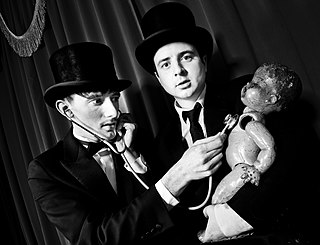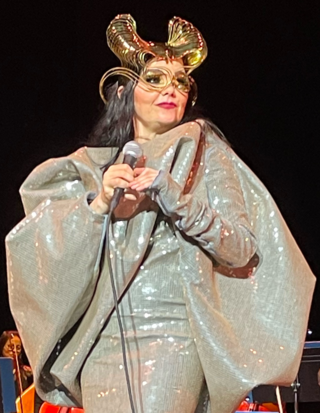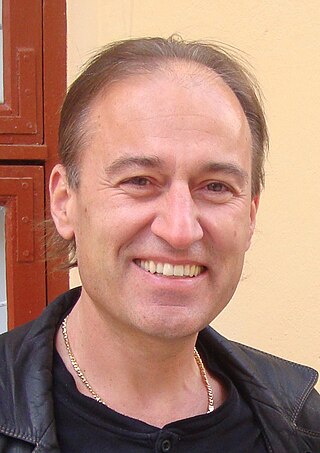
A storyboard is a graphic organizer that consists of illustrations or images displayed in sequence for the purpose of pre-visualizing a motion picture, animation, motion graphic or interactive media sequence. The storyboarding process, in the form it is known today, was developed at Walt Disney Productions during the early 1930s, after several years of similar processes being in use at Walt Disney and other animation studios.

Michael John Kricfalusi, known professionally as John K., is a Canadian illustrator and blogger, as well as a former animator and voice actor. He is the creator of the animated television series The Ren & Stimpy Show, which was highly influential on televised animation during the 1990s. From 1989 to 1992, he was heavily involved with the first two seasons of the show in virtually every aspect of its production, including providing the voice of Ren Höek and other characters. In 2009, he won the Inkpot Award.
Animusic, LLC is a dormant animation company specializing in the 3D visualization of MIDI-based music. Founded by Wayne Lytle, it is currently a registered limited liability company in New York and had offices in Texas and California during its active stages. The initial name of the company was Visual Music, but was changed to Animusic in 1995.

Howard Simon Bernstein, professionally known as Howie B, is a Scottish musician, producer and DJ who has worked with artists including Björk, U2, Tricky, Siouxsie and the Banshees, Soul II Soul, Robbie Robertson, Elisa, Mukul Deora, Marlene Kuntz and the Gift.

Music visualization or music visualisation, a feature found in electronic music visualizers and media player software, generates animated imagery based on a piece of music. The imagery is usually generated and rendered in real time and in a way synchronized with the music as it is played.

Waikato Environment for Knowledge Analysis (Weka) is a collection of machine learning and data analysis free software licensed under the GNU General Public License. It was developed at the University of Waikato, New Zealand and is the companion software to the book "Data Mining: Practical Machine Learning Tools and Techniques".
Visual music, sometimes called color music, refers to the creation of a visual analogue to musical form by adapting musical structures for visual composition, which can also include silent films or silent Lumia work. It also refers to methods or devices which can translate sounds or music into a related visual presentation. An expanded definition may include the translation of music to painting; this was the original definition of the term, as coined by Roger Fry in 1912 to describe the work of Wassily Kandinsky. There are a variety of definitions of visual music, particularly as the field continues to expand. In some recent writing, usually in the fine art world, visual music is often confused with or defined as synaesthesia, though historically this has never been a definition of visual music. Visual music has also been defined as a form of intermedia.

Patrick M. Hanrahan is an American computer graphics researcher, the Canon USA Professor of Computer Science and Electrical Engineering in the Computer Graphics Laboratory at Stanford University. His research focuses on rendering algorithms, graphics processing units, as well as scientific illustration and visualization. He has received numerous awards, including the 2019 Turing Award.

16bit were an English electronic music duo, consisting of Eddie Jefferys and Jason Morrison. They were signed to Chase & Status' MTA Records, and best known for their work with Björk.
George G. Robertson is an American information visualization expert and senior researcher, Visualization and Interaction (VIBE) Research Group, Microsoft Research. With Stuart K. Card, Jock D. Mackinlay and others he invented a number of Information Visualization techniques.
Jock D. Mackinlay is an American information visualization expert and Vice President of Research and Design at Tableau Software. With Stuart Card, George G. Robertson and others he invented a number of information visualization techniques.

Computer graphics deals with generating images and art with the aid of computers. Today, computer graphics is a core technology in digital photography, film, video games, digital art, cell phone and computer displays, and many specialized applications. A great deal of specialized hardware and software has been developed, with the displays of most devices being driven by computer graphics hardware. It is a vast and recently developed area of computer science. The phrase was coined in 1960 by computer graphics researchers Verne Hudson and William Fetter of Boeing. It is often abbreviated as CG, or typically in the context of film as computer generated imagery (CGI). The non-artistic aspects of computer graphics are the subject of computer science research.

Björk Guðmundsdóttir is an Icelandic singer, songwriter, composer, record producer, and actress. Noted for her distinct three-octave vocal range and eccentric persona, she has developed an eclectic musical style over her four-decade career that has drawn on electronic, pop, experimental, trip hop, classical, and avant-garde music.
The history of computer animation began as early as the 1940s and 1950s, when people began to experiment with computer graphics – most notably by John Whitney. It was only by the early 1960s when digital computers had become widely established, that new avenues for innovative computer graphics blossomed. Initially, uses were mainly for scientific, engineering and other research purposes, but artistic experimentation began to make its appearance by the mid-1960s – most notably by Dr Thomas Calvert. By the mid-1970s, many such efforts were beginning to enter into public media. Much computer graphics at this time involved 2-dimensional imagery, though increasingly as computer power improved, efforts to achieve 3-dimensional realism became the emphasis. By the late 1980s, photo-realistic 3D was beginning to appear in film movies, and by mid-1990s had developed to the point where 3D animation could be used for entire feature film production.

Biophilia is the seventh studio album by Icelandic singer Björk. It was released on 5 October 2011 by One Little Indian Records and distributed by Nonesuch Records in North America and by Universal Music Group in the rest of the world. Björk composed it as a concept album during the 2008–2011 Icelandic financial crisis, exploring the links between nature, music and technology. Billed as the first "app album", Biophilia is a multimedia project released alongside a series of apps linking the album's themes to musicology concepts. It was followed by a series of educational workshops on four continents.

Computer-generated imagery (CGI) is a specific-technology or application of computer graphics for creating or improving images in art, printed media, simulators, videos and video games. These images are either static or dynamic. CGI both refers to 2D computer graphics and 3D computer graphics with the purpose of designing characters, virtual worlds, or scenes and special effects. The application of CGI for creating/improving animations is called computer animation, or CGI animation.
Drew Berry is an American biomedical animator at the Walter and Eliza Hall Institute of Medical Research in Melbourne, Australia. He produces animations of proteins and protein complexes to illustrate cellular and molecular processes.

Markus Gross is a Professor of Computer science at the Swiss Federal Institute of Technology Zürich (ETH), head of its Computer Graphics Laboratory, and the director of Disney Research, Zurich. His research interests include physically based modeling, computer animation, immersive displays, and video technology. He has published more than 430 scientific papers on algorithms and methods in the field of computer graphics and computer vision, and holds more than 30 patents. He has graduated more than 60 Ph.D. students.

Tri Angle was an English record label based in London and New York established by Robin Carolan in 2010. The label released albums by serpentwithfeet, The Haxan Cloak, Vessel, Forest Swords, Holy Other, and Clams Casino.
Jesse Kanda is an artist, animator and musician based in London. He was born in Japan and raised in Canada. Besides his solo career as an artist and musician, he is also well known for his collaborations with musicians including Arca, FKA Twigs and Björk as well as providing visuals for fashion label Hood By Air.













